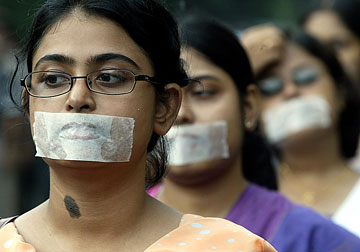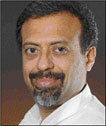 ASSOCIATED PRESS / 2006 Medical students in Calcutta, India, walk in a silent rally protesting police atrocities against them during an earlier protest against quota-based programs for Other Backward Castes. The programs seem to be, in effect, pitting members of different castes against one another. CLICK FOR LARGE |
|
Re-caste-ing India
Sixty years after it was supposed to be abolished, the caste system tightens its grip on India
Asian Outlook
S. Shankar
A VERITABLE storm has broken loose in India because of the proposal by its federal government, led by Sonia Gandhi's Congress Party with support from the left, to extend quota-based affirmative action programs to Other Backward Castes. The move has laid bare the festering wound at the heart of Indian society. Much has been written about India's religious animosities, but caste-based divisions are an equal challenge in this ancient civilization's drive to adapt to a modern world.
In the aftermath of independence in 1947, India abolished caste-based discrimination, but the deep divisions of caste continue to shape the actual lives of millions of Indians. Farthest down on this caste hierarchy are the so-called "untouchables," termed Scheduled Castes in the legal nomenclature of the Indian state because of the schedule, or list, in which qualifying castes are identified. Located somewhat differently within India's social structure, but equally exploited, are the Scheduled Tribes, regarded as aborigines.
 S. Shankar |
QUOTA-BASED affirmative action programs have long existed for the Scheduled Castes and Scheduled Tribes. Now the government proposes a similar quota for the numerically larger Other Backward Castes in educational institutions as well as public sector jobs. The OBCs are higher than the SCs and STs in the caste hierarchy but below the Forward Castes, whose access to educational and employment opportunities is in danger of shrinking dramatically. Hence the loud and emotional protests that have greeted the federal government's initiative.
No one mindful of the intransigence of caste-based exploitation in contemporary India can disregard the merits of the federal government's initiative. The experience of certain regions -- such as the South -- suggests that extensive quota-based affirmative action programs do produce results, and without imposing unacceptable costs on the Forward Castes. Yet we should not overlook one ironic outcome of these initiatives: Even as they are intended to be anti-caste, they make caste ever more entrenched.
SIMILARLY, India's vibrant modern democracy, which routinely votes governments in and out of power at every level, also has paradoxically strengthened caste-based identities. Political parties all too often choose candidates based on the relative strength of castes in a particular constituency. When I recently traveled in the southern district of Thirunelveli in the aftermath of provincial elections, I talked to a wide spectrum of people from many different castes. It was clear that voters approached the elections largely through the prism of caste. Castes have become vote banks in modern India, a calculation that surely is not unrelated to the federal government's enthusiasm for quotas for OBCs.
We are left then with a disquieting paradox. The very institutions and processes meant to redress deeply entrenched divisions within India and modernize the country -- elections and modern educational institutions and jobs -- are ensuring the continuation of these divisions. Abhorrent practices associated with caste discrimination have indeed weakened in many parts of India, often because of the power of choice represented by the vote and the upward economic mobility made possible by quotas. Deep in the hinterland of Thirunelveli District, I, born a Brahmin, am able to sit, sharing food, with Nadars and Thevars and Dalits (the preferred name for Scheduled Castes) and have an amiable conversation about the recent elections.
Yet it would be a mistake to conclude from this that caste itself is weakening. Rather than weakening, caste is metamorphosing in contemporary India. In coming decades, India will struggle mightily with the bewildering consequences of this development.
S. Shankar, author of "No End to the Journey," teaches in the Department of English and is the director of the Center for South Asian Studies at the University of Hawai-Manoa. Reach him at
subraman@hawaii.edu

